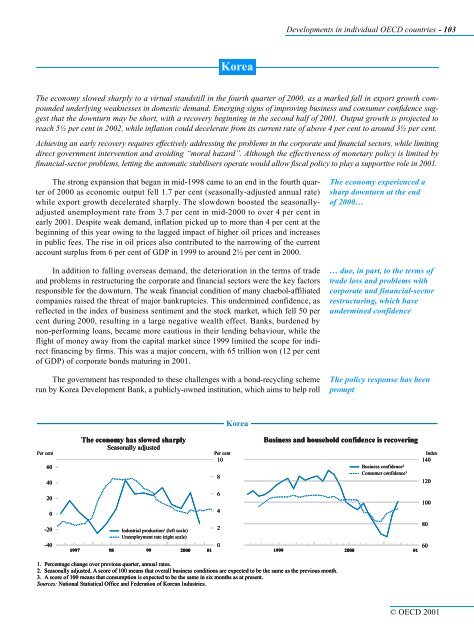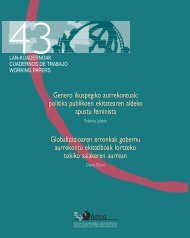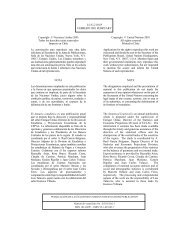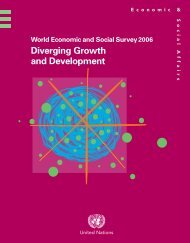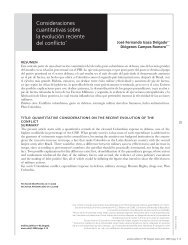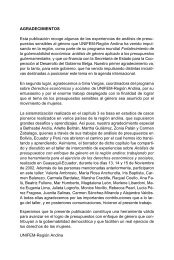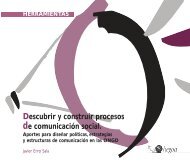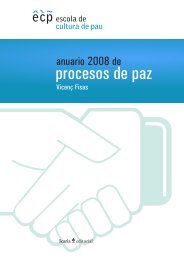OECD Economic Outlook 69 - Biblioteca Hegoa
OECD Economic Outlook 69 - Biblioteca Hegoa
OECD Economic Outlook 69 - Biblioteca Hegoa
Create successful ePaper yourself
Turn your PDF publications into a flip-book with our unique Google optimized e-Paper software.
Korea<br />
Developments in individual <strong>OECD</strong> countries - 103<br />
The economy slowed sharply to a virtual standstill in the fourth quarter of 2000, as a marked fall in export growth compounded<br />
underlying weaknesses in domestic demand. Emerging signs of improving business and consumer confidence suggest<br />
that the downturn may be short, with a recovery beginning in the second half of 2001. Output growth is projected to<br />
reach 5½ per cent in 2002, while inflation could decelerate from its current rate of above 4 per cent to around 3½ per cent.<br />
Achieving an early recovery requires effectively addressing the problems in the corporate and financial sectors, while limiting<br />
direct government intervention and avoiding “moral hazard”. Although the effectiveness of monetary policy is limited by<br />
financial-sector problems, letting the automatic stabilisers operate would allow fiscal policy to play a supportive role in 2001.<br />
The strong expansion that began in mid-1998 came to an end in the fourth quarter<br />
of 2000 as economic output fell 1.7 per cent (seasonally-adjusted annual rate)<br />
while export growth decelerated sharply. The slowdown boosted the seasonallyadjusted<br />
unemployment rate from 3.7 per cent in mid-2000 to over 4 per cent in<br />
early 2001. Despite weak demand, inflation picked up to more than 4 per cent at the<br />
beginning of this year owing to the lagged impact of higher oil prices and increases<br />
in public fees. The rise in oil prices also contributed to the narrowing of the current<br />
account surplus from 6 per cent of GDP in 1999 to around 2½ per cent in 2000.<br />
In addition to falling overseas demand, the deterioration in the terms of trade<br />
and problems in restructuring the corporate and financial sectors were the key factors<br />
responsible for the downturn. The weak financial condition of many chaebol-affiliated<br />
companies raised the threat of major bankruptcies. This undermined confidence, as<br />
reflected in the index of business sentiment and the stock market, which fell 50 per<br />
cent during 2000, resulting in a large negative wealth effect. Banks, burdened by<br />
non-performing loans, became more cautious in their lending behaviour, while the<br />
flight of money away from the capital market since 1999 limited the scope for indirect<br />
financing by firms. This was a major concern, with 65 trillion won (12 per cent<br />
of GDP) of corporate bonds maturing in 2001.<br />
The government has responded to these challenges with a bond-recycling scheme<br />
run by Korea Development Bank, a publicly-owned institution, which aims to help roll<br />
Korea<br />
The economy experienced a<br />
sharp downturn at the end<br />
of 2000…<br />
… due, in part, to the terms of<br />
trade loss and problems with<br />
corporate and financial-sector<br />
restructuring, which have<br />
undermined confidence<br />
The policy response has been<br />
prompt<br />
The economy has slowed sharply<br />
Seasonally adjusted<br />
Business and household confidence is recovering<br />
Per cent Per cent Index<br />
10<br />
140<br />
60<br />
40<br />
8<br />
120<br />
20<br />
6<br />
100<br />
0<br />
4<br />
-20<br />
Industrial production 2<br />
80<br />
-40<br />
1997<br />
98 99 2000 01<br />
0<br />
1999 2000 01<br />
60<br />
1 Business confidence<br />
(left scale)<br />
Unemployment rate (right scale)<br />
2<br />
Consumer confidence3 The economy has slowed sharply<br />
Seasonally adjusted<br />
Business and household confidence is recovering<br />
Per cent Per cent Index<br />
10<br />
140<br />
60<br />
40<br />
8<br />
120<br />
20<br />
6<br />
100<br />
0<br />
4<br />
-20<br />
Industrial production 2<br />
80<br />
-40<br />
1997<br />
98 99 2000 01<br />
0<br />
1999 2000 01<br />
60<br />
1 Business confidence<br />
(left scale)<br />
Unemployment rate (right scale)<br />
2<br />
Consumer confidence3 The economy has slowed sharply<br />
Seasonally adjusted<br />
Business and household confidence is recovering<br />
Per cent Per cent Index<br />
10<br />
140<br />
60<br />
40<br />
8<br />
120<br />
20<br />
6<br />
100<br />
0<br />
4<br />
-20<br />
Industrial production 2<br />
80<br />
-40<br />
1997<br />
98 99 2000 01<br />
0<br />
1999 2000 01<br />
60<br />
1 Business confidence<br />
(left scale)<br />
Unemployment rate (right scale)<br />
2<br />
Consumer confidence3 1. Percentage change over previous quarter, annual rates.<br />
2. Seasonally adjusted. A score of 100 means that overall business conditions are expected to be the same as the previous month.<br />
3. A score of 100 means that consumption is expected to be the same in six months as at present.<br />
Sources: National Statistical Office and Federation of Korean Industries.<br />
© <strong>OECD</strong> 2001


